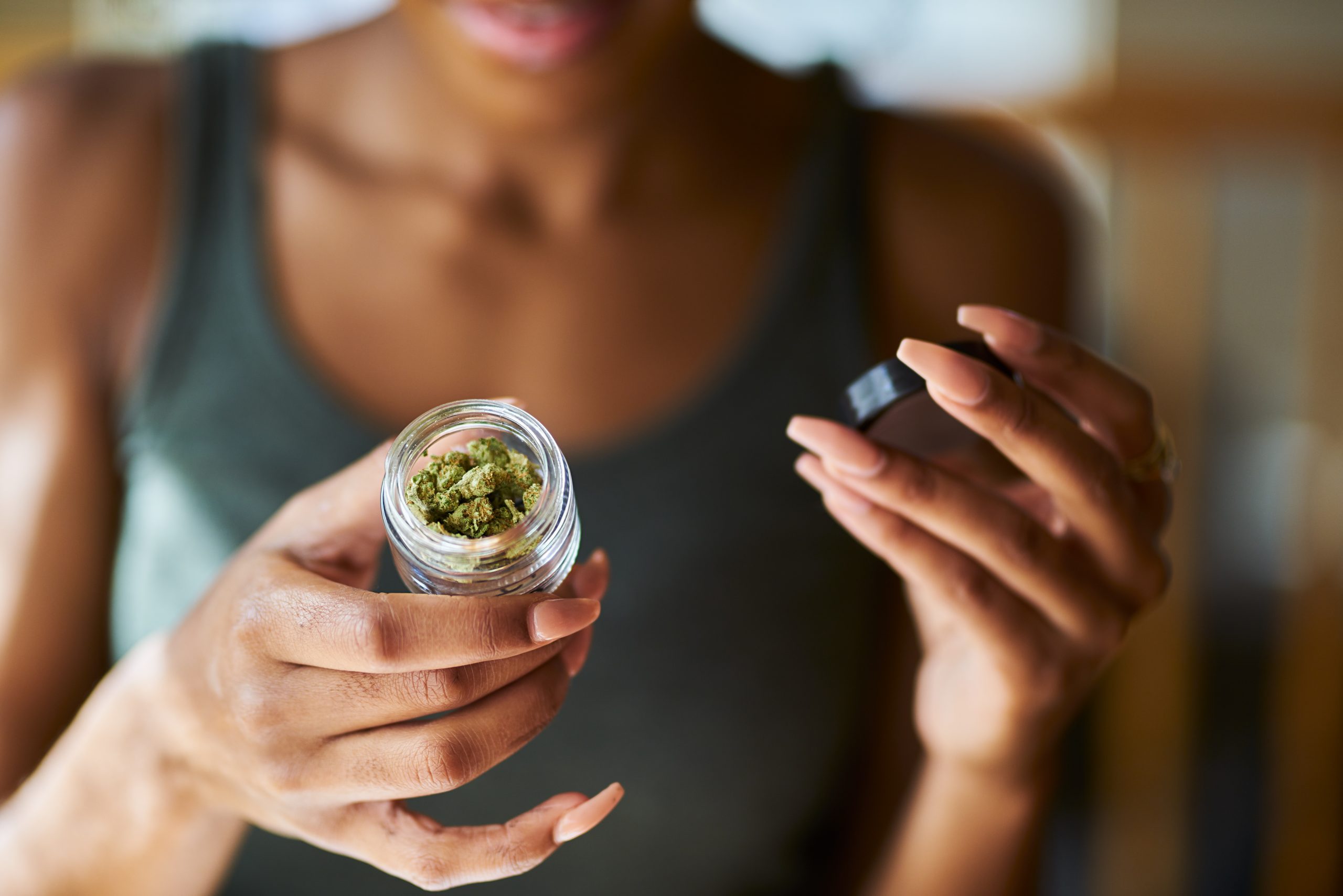Menopause & Cannabis
Recommendations During Menopause
Cannabis & Other Medications
Menopause and Cannabis
The symptoms associated with the menopausal transition, or perimenopause, can cause significant challenges for many women. One recent study that looked at the value of menopausal symptom relief to women in the US found that half of the study participants (1753 of 3397 women, or 52%) would choose to reduce their lifespan by up to three months instead of experiencing their symptoms at the most bothersome level for 30 days. [1]
Yes.
You read that correctly.
Half of women surveyed would rather die early than experience their worst perimenopause symptoms for a month. [1]
Women are desperate for relief from their symptoms and most have learned that the existing medical system is not yet capable of providing relevant information, individual answers, and most importantly, personalized help.
Enter cannabis, commonly known as marijuana.
It is the third most commonly used psychoactive substance worldwide, after alcohol and tobacco. It has euphorigenic (gives you a “high”), sedative, and analgesic properties that are primarily due to one cannabinoid: delta-9-tetrahydrocannabinol (THC). The concentration of THC is commonly used as a measure of cannabis potency. [2]
One recent study [3] looked at a sample of 232 women with an average age of 55.95 yrs in Northern California who participated in the Midlife Women Veterans Health Survey, of which half reported bothersome menopausal transition symptoms including hot flashes and night sweats, insomnia, and genitourinary symptoms.
Of these women:

had used or were currently using cannabis to manage their symptoms

were willing to try cannabis to manage their symptoms
Age, ethnicity, socioeconomic status, or mental health condition did not appear to factor into the choice to use cannabis. The authors highlight that there is little-to-no current research addressing whether cannabis use is safe or effective for menopause symptom management, and so more research in this area is needed. [3]
Is Cannabis Use Safe?
Cannabis may be legal, but there are still safety concerns around its use. The ingredient in cannabis that gives you the high is a chemical called THC. Prior to the 1990s, the THC content in illegal cannabis was less than 2%. By 2017, the THC content for some legal cannabis was as high as 28%. These levels of THC cannot cause a fatal overdose, but there are health concerns, including acute toxicity and Cannabis Hyperemesis Syndrome (frequent, severe nausea and vomiting) that may require hospitalization. [21]
Be cautious and ask questions when you are purchasing cannabis. Use a regulated dispensary if at all possible to give you confidence in the quality of the cannabis product. And talk to your healthcare provider – make sure they are aware if you are choosing to use cannabis.
What are the Health Effects of Cannabis?
Research on cannabis and anxiety is in early stages having been done primarily in rats and mice, yet the results to date are clear:
cannabinoids impact anxiety in complex and often contradictory ways.
For example, one study has shown that both cannabinoid activation from either the your internal system or from ingesting cannabinoids can impact anxiety – lower doses seem to reduce anxiety whereas higher doses are perceived to increase it. [4] [5]
In 2017 a committee of experts was convened by the National Academies of Sciences, Engineering, and Medicine to perform a review of existing research to evaluate the evidence for health effects of marijuana. [6] These are some of their findings that may directly inform your thinking around using cannabis to help with your menopausal transition symptoms:
What are the Recommendations for Cannabis during Menopause?
At the moment there are no specific recommendations for the use of cannabis to help with menopausal transition symptoms. In addition, the risks may not be the same from person to person, or from one episode of use to another.
The Lower-Risk Cannabis Use Guidelines (LRCUG): A Comprehensive Update of Evidence and Recommendations [7] are based on a comprehensive review of scientific studies and data conducted by an international team of addiction and health experts. They state that those who decide to use cannabis incur a variety of risks related to acute and/or long-term adverse health and social outcomes.
In Canada, the LRCUG has been endorsed by the Canadian Medical Association, the Canadian Public Health Association, the Canadian Mental Health Association, the Centre for Addiction and Mental Health, and the Council of Chief Medical Officers of Health (CCMOH). These are the key messages:
- Use products with low THC content and high CBD:THC ratios
- Synthetic cannabis products, such as K2 and Spice, should be avoided
- Avoid smoking burnt cannabis and choose safer inhalation methods including vaporizers, e-cigarette devices and edibles
- If cannabis is smoked, avoid harmful practices such as inhaling deeply or breath-holding
- Avoid frequent or intensive use, and limit consumption to occasional use, such as only one day a week or on weekends, or less
- Do not drive or operate other machinery for at least 6 hours after using cannabis
- Combining alcohol and cannabis increases impairment and should be avoided
- People with a personal or family history of psychosis or substance use disorders, as well as pregnant women, should not use cannabis at all [7]

Cannabis and Other Medications
Despite the prevalence of cannabis use, particularly with legalization of recreational cannabis, research is still lacking about the overall health benefits and medicinal status of cannabis. Regardless, the chemical compounds in cannabis, like any other drug, can interact with other medications that you are taking. Enzymes in your body are specialized to metabolize, or break down, different compounds. The two best-known compounds in cannabis – THC and CBD – are also known to impact the actions of enzymes in your body, interfering with how well these enzymes can do their work and break down their target molecules – which may be other medications you are currently taking.
It is vital to talk to your healthcare provider and let them know if you use cannabis.
They are not there to judge you, rather they are there to protect you from unforeseen consequences of mixing drugs.
Women in the menopausal transition are often prescribed drugs, including anti-depressants, to manage bothersome symptoms, so be aware that cannabis can have an impact on these medications.
For example: cannabidiol (CBD) is known to increase levels of Selective Serotonin Reuptake Inhibitors (SSRIs), Tricyclic Antidepressants (TCAs), antipsychotic medications, beta blockers and opioids (including codeine and oxycodone) in the bloodstream.[8][9][10] This happens because CBD inhibits the action of the CYP2D6 enzyme which works to break down these types of drugs, so they do not get cleared out of the body as quickly as they normally would. These drugs aren’t wasted but because they don’t get broken down as quickly, they are available for use while they circulate. The issue is that you will then take the next dose of your SSRI on the assumption that there is a particular level of drug circulating in your system, but you would be incorrect. There is a higher level in your system, so there is the potential to overmedicate.
If you are using CBD, understand that you likely have more of your SSRI, TCA, or other medications in your blood than you have been prescribed!
Make sure you speak with your healthcare provider and let them know if you are using cannabis.
THC also impacts certain enzymes as it is a known inducer of CYP1A2, causing it to activate and break down certain drugs, including serotonin-norepinephrine reuptake inhibitor (SNRIs), faster than normal. This means that if you are using SNRI antidepressants, using THC will reduce the levels that are circulating in your system. [8] [9] [10]
MYTH
Some research suggests that marijuana use is likely to precede the use of other illicit substances and the development of addiction to other substances. However, the same report also found that the majority of people who use marijuana do not go on to use other “harder” substances. The authors note that multiple other factors, including a person’s social environment, are also critical in a person’s risk for drug use. They present an alternative to cannabis as a gateway-drug hypothesis by suggesting that people who are more vulnerable to drug-use are more likely to start with readily available substances such as tobacco, or alcohol. Subsequent social interactions with other drug users increases the chance of them trying other drugs. [18]
MYTH
Current evidence is inconclusive on whether smoking cannabis can cause cancer in the same way as tobacco, however there is strong evidence that smoking cannabis leads to respiratory tract problems such as chronic bronchitis and Chronic Obstructive Pulmonary Disorder (COPD). Smoking anything can be harmful due to the carbon monoxide that is produced due to the combustion process. It is recommended that cannabis smokers use alternative methods such as a vaporizer, which heats cannabis at a lower temperature without smoke, or edible products such as gummies or chocolate.
MYSTERY
There is risk to both alcohol and cannabis use. Alcohol is a proven carcinogen, and it contributes to accidental injury and poisoning which can cause death. The link between cannabis and cancer is unknown at this time so it may, in time, also prove to be a carcinogen. There are other health issues associated with smoking cannabis, such as the known link to respiratory tract problems including chronic bronchitis and Chronic Obstructive Pulmonary Disorder (COPD). Neither cannabis nor alcohol should be used before driving or operating machinery as both interfere with cognitive function and reaction times.
MYTH
No, you cannot overdose on cannabis. It is entirely possible to consume too much cannabis and feel sick, dizzy and nauseous but there have been no reported deaths due to an overdose of cannabis. Determining what is ‘too much cannabis’ is a personal decision that depends on frequency of cannabis use (the more frequent your use, the more likely you will develop a higher tolerance for any effects) and whether your individual reactions are negative, such as experiencing paranoia, anxiety, or frequent coughing.
TRUE
Despite popular belief, you can become dependent on cannabis and feel withdrawal if you don’t use it after frequent or daily use. Symptoms of withdrawal include mood changes, sleep difficulties, headaches, loss of focus, cravings for cannabis, sweating and chills, and stomach problems. Approximately 9 % of people who use marijuana will become dependent on it. This number rises to approximately 17% for individuals who start using cannabis in their teens. [19]
MYTH
Unless the crime is overeating at your local buffet restaurant, cannabis is not typically associated with increased levels of crime and delinquency. Unlike alcohol, cannabis doesn’t usually cause increased aggression so the link to violent crime is low. However, cannabis is known to lead to psychosis in some individuals and this psychosis is a high risk factor for violence. As with many of the studies on cannabis as a gateway drug, a direct causal link between cannabis and crime is hard to find. [20]
Compiled References
[1] Craig BM, Mitchell SA. Examining the Value of Menopausal Symptom Relief Among US Women. Value Health. 2016 Mar-Apr;19(2):158-66. doi: 10.1016/j.jval.2015.11.002. Epub 2015 Dec 4. PMID: 27021749.
[2] https://www.uptodate.com/contents/cannabis-use-epidemiology-pharmacology-comorbidities-and-adverse-effects
3] https://www.menopause.org/docs/default-source/press-release/cannabis-use-for-menopause-9-17-20.pdf
[4] Andrade AK, Renda B, Murray JE. Cannabinoids, interoception, and anxiety. Pharmacol Biochem Behav. 2019 May;180:60-73. doi: 10.1016/j.pbb.2019.03.006. Epub 2019 Mar 25. PMID: 30922834.
[5] M.P. Viveros, Eva M. Marco, Sandra E. File, Endocannabinoid system and stress and anxiety responses, Pharmacology Biochemistry and Behavior, Volume 81, Issue 2, 2005, pp 331-342, ISSN 0091-3057, DOI:10.1016/j.pbb.2005.01.029
[6] National Academies of Sciences, Engineering, and Medicine; Health and Medicine Division; Board on Population Health and Public Health Practice; Committee on the Health Effects of Marijuana: An Evidence Review and Research Agenda. The Health Effects of Cannabis and Cannabinoids: The Current State of Evidence and Recommendations for Research. Washington (DC): National Academies Press (US); 2017 Jan 12. 12, Mental Health. Available from: https://www.ncbi.nlm.nih.gov/books/NBK425748/
[7] Fischer, B., Russell, C., Sabioni, P., van den Brink, W., Le Foll, B., Hall, W., Rehm, J. & Room, R. (2017). Lower-Risk Cannabis Use Guidelines (LRCUG): A Comprehensive Update of Evidence and Recommendations. American Journal of Public Health, 107(8). DOI: 10.2105/AJPH.2017.303818.
** In Canada, the LRCUG has been endorsed by the Canadian Medical Association, the Canadian Public Health Association, the Canadian Mental Health Association, the Centre for Addiction and Mental Health, and the Council of Chief Medical Officers of Health (CCMOH).
[8] https://doh.dc.gov/sites/default/files/dc/sites/doh/publication/attachments/Medical%20Cannabis%20Adverse%20Effects%20and%20Drug%20Interactions_0.pdf
[9] Tambaro, S., & Bortolato, M. (2012). Cannabinoid-related agents in the treatment of anxiety disorders: current knowledge and future perspectives. Recent patents on CNS drug discovery, 7(1), 25–40. https://doi.org/10.2174/157488912798842269
[10] https://doh.dc.gov/sites/default/files/dc/sites/doh/publication/attachments/Medical%20Cannabis%20Adverse%20Effects%20and%20Drug%20Interactions_0.pdf
[11] Lu, H. C., & Mackie, K. (2016). An Introduction to the Endogenous Cannabinoid System. Biological psychiatry, 79(7), 516–525. https://doi.org/10.1016/j.biopsych.2015.07.028
[12] https://www.healthline.com/health/endocannabinoid-system
[13] Alger B. E. (2013). Getting high on the endocannabinoid system. Cerebrum : the Dana forum on brain science, 2013, 14.
[14] https://www.health.harvard.edu/blog/the-endocannabinoid-system-essential-and-mysterious-202108112569
[15] Avery Michael C., Krichmar Jeffrey L. Neuromodulatory Systems and Their Interactions: A Review of Models, Theories, and Experiments. Frontiers in Neural Circuits 2017 Volume 11 DOI: 10.3389/fncir.2017.00108
[16] https://www.healthline.com/health/what-is-cannabis#components
[17] https://www.healthline.com/health/cbd-vs-thc
[18] Secades-Villa R, Garcia-Rodríguez O, Jin CJ, Wang S, Blanco C. Probability and predictors of the cannabis gateway effect: a national study. Int J Drug Policy. 2015;26(2):135-142. doi:10.1016/j.drugpo.2014.07.011
[19] https://nida.nih.gov/publications/research-reports/marijuana/letter-director
[20] Berenson A. (2019). Marijuana Is More Dangerous Than You Think. Missouri medicine, 116(2), 88–89.
[21] https://my.clevelandclinic.org/health/diseases/21665-cannabis-hyperemesis-syndrome/span>
Original content, last updated March 30, 2023.
© 2025 Herstasis® Health Foundation



